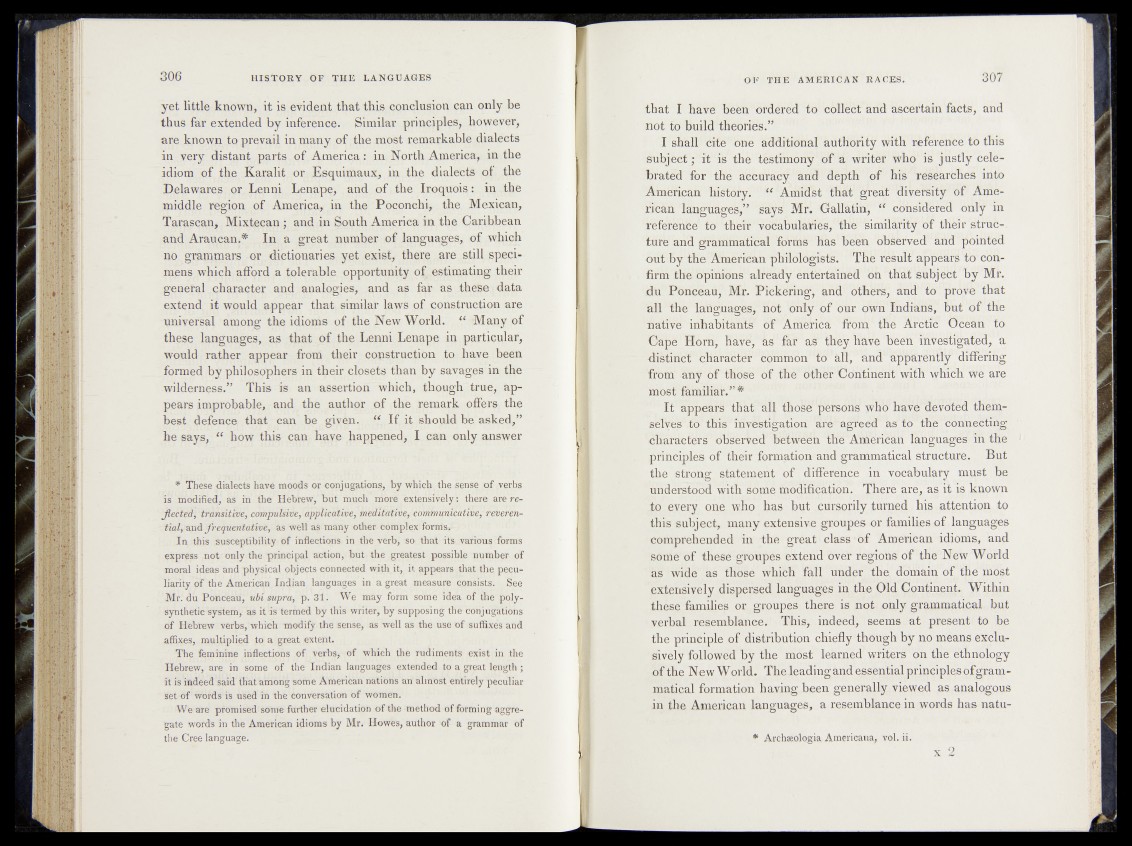
yet little known, it is evident that this, conclusion can only he
thus far extended by inference. Similar principles, however,
are known to prevail in many of the most remarkable dialects
in very distant parts of America : in North America, in the
idiom of the Karalit or. ;Esqui^ux,, in the dialects of the
Delawares or Lenni Lenape, and of the Iragiioig.
middle region of America, in the Poconchi, the Mexican,
Tarascan, Mixtecan ; and in South America in the Caribbean
and Araucan,* In a great number of languages, of which
no gratnmars or dictionaries yet exist, there are still specimens
which afford a tolerable opportunity of estimating their
general character and analogies, and as far as these g data
extend.' it would appear that similar laws of construction are
universal among the idioms of the New World. | | | Many of
these languages, as that of the Lenni Lenape in particular,
would rather appear from their construction to have been
formed by philosophers in their closets than by savages in the
wilderness.” This is an assertion- which, though true, appears
improbable, and the author of the remark offers the
best defence that can be given. “ I f it should be asked,”
he says, “ how this can have happened, I can only answer
* These dialects have moods or conjugations, by which the sense of „verbs
is modified, as in the Hebrew, but much ''m^^'exteufflvely£<^diere are reflected;
transitive, compulsive, applicative, ineditativo,'eombiunicati,pi;fiei)eFen-
tial, frequentative, as well as many other complex form’s*
,ln,;this susceptibility of inflections in the verb, so that its. various forms
express not only the principal action, but the greatest possible number of
moral ideas and physical objects connected with,it, it appears that the peculiarity
of the American Indian languages in a great measure consists. ' See
Mr. du Ponceau, ubi supra, p. 31. We may form some idea of the poly-
synthetic system, as it is termed by this writer, by supposing the conjugations
pf Hebrew verbs, which modify the sense, as well as the use of suffixes and
affixes, multiplied to a great extent.
The feminine inflections of verbs, of which the rudiments exist in the
Hebrew, are. in some of the Indian languages extended to a great length;
it is indeed said that among some American nations art almost entirely peculiar
set 6f words is used in the conversation of women.
We are promised some further elucidation of the method of forming aggregate
words in the American idioms by Mr. Howes, author of a grammar of
the Cree language.
that I have been brdefesd "to WMle^ct and ascertain facts, and
not to build'ttie'oribs.” “^
I shall eitV:bzie additional authority with reference to this
subject,* it is the testimony "of a writer who is justly celebrated
for the a'ecutac^and' depth of' his researches into
American lfi^foryfi% Amidst tbat!:great ^iversiity's of American
’Ithagiiages,” ' M K Oalfetih^J co'hriderea *onVy in
fefe^enbe# to their vobabularie^^tlm feimilariiy‘ifr their stfiic-
turb aricl grairimatical form& 'lias'been observed’' and pointed
out by‘the American philologists. The rbsult appears fo’ confirm
tffe Opinions already entertained bn 'that subj eet by Mr.
dk. Pbhcbau, Mr. Pickering, hhd^ others,' a’n!d'f‘t!ol prove f,that
all the language's, not Only bf !our own Inddams, but of the
natiyd inhabitants’ fPoni” the Itrenc Ocean to
ISaifje Dorh] fi^,v^Kas!! fid’' as0 theV n^Ye^eeh0mvestigarea, z.
-distinct chara€t?CT'' commonutb all, andh‘apparehtly riitfering/
;lrbm .any ofHhbsb of .the' dthef ^^t^Milwith'iVlh^^wipfo
most familiar.” #
It appears "that all thosephrsoris^ wlidhave pevoted thein-
^elvbs^to this^Mvefetlgation are agreea as. to" toe vcofineHing
dharactdrs^d^r^ed between the^Arperichri IaHgu.age^ m the
principles of- their formation and grammatica'Vstrnetuxe. But
the' efrong statement of .difference in vocabulary must be
understood with some modification. There are, as it is known
to every one who has but cursorily turned hjs,,attention to
this subject* many extensive groupes or familiesjo£>languages
comprehended in the great class‘ of Ameriban idioms, hud
some of these groupes extend ovet jfegiohs or'the New World
which fall underf’the"domain of the1'most
extensively dispersed languages in the Old Qpnfcinent» Within
these families or groupeSi there is not only grammatical but
verbalresemblance:* This, indeed, ■ seems aLpresent to Jap
the principle of distribution chiefly'though by no means exclusively
followed by the most learned' writers1 on the ethnology
of the New World. The leading and’esserttial principles of grammatical
formation having been generally viewed analogous
in the American languages, a resemblance in.words has matu-
* Arch«ologia Americana, vol. ii.
x 2 i